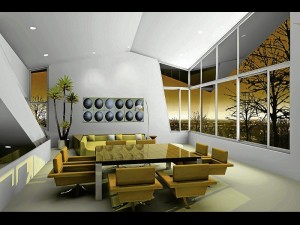
WIDE roof eaves provide shading from direct sun rays, while natural daylight enters through large windows. Natural light is harnessed.
I was at the Manila Construction show, the “ManilaCon 2011,” a few weeks ago and sat through snippets of the 8th Green Forum: “The Cost and Cons of Going Green.” The forum featured speakers who shared the different approaches by which sustainability—the responsible use of energy, resources and the environment—can be adapted in design. Ultimately, the goal of the discussions was to inspire architects, designers, engineers and other related professionals, with ways to go green without necessarily going expensive.
Green rating systems like the US-developed “LEED” (Leadership in Energy and Environmental Design) and the local rating system “Berde” by the Philippine Green Council, have made sustainability quite intimidating and seemingly difficult to achieve. These rating systems demand certain measurable standards be met prior to any recognition to being “green.” Becoming authentically environment-friendly often gets lost in the commercialization of the so-called “sustainable products” pushed into the market because they garner the needed “points” that will add up to a “Certified Green” building.
But going green need not be “certified” all the time. Rating systems help in validating and supporting commercial projects promoting themselves as “sustainable,” which nowadays, is a strong—and sometimes deceptive—angle to sell a product. But for those without commercial interests and have only the pure intention of reducing damage to the environment, going green can be approached in so many simple ways.
At the forum, green-building advocate—architect Miguel “Mike” Guerrero, cochair of the Green Forum, and founding member of the Philippine Green Building Council—shared his thoughts on sustainable design in the country. Mike holds monthly Green Architecture discussions and gathered that the two main issues hampering the development of sustainable design in our communities are simply the lack of awareness, and sadly, the notion that it is expensive.
Here, architect Mike Guerrero sums up his 10 (short, simple, practical and inexpensive) steps to employing sustainable design:
- Keep the sun out. The Philippines, a tropical country, has quite high ambient temperature. To reduce the heat inside the building, the direct sun rays, especially from the east and west, must be blocked by walls or sun-shading devices.
- Let the light in. There is a lot of ambient lighting during the day. Allowing natural daylight to enter the building through the north and south windows will reduce reliance on artificial or electrical lights.
- Catch the breeze. The Philippines has a regular wind cycle pattern. The northeast breeze occurs during the cool months, while the southwest breeze during summer. Using windows or building form to catch the breeze can reduce further the interior heat.
- Insulate the roof. The roof is exposed to the direct sunlight most of the day. There are several options to reducing this heat from entering the building—heat insulation below the metal roof sheet, spray-on insulation above the metal roof sheet, or use concrete/clay tiles.
- Harvest rainwater. Cost of water is increasing. But we tend to continue using potable water to flush the toilets, water the garden and wash the car. The natural cycle brings rain to the Philippines. Why not capture this rainfall and use for the garden, cleaning the car and even for flushing the toilets.
- Recycle wastewater. For additional nonpotable water supply, consider recycling wastewater that is treated. Wastewater could be treated with a traditional septic tank and an engineered reed bed. Some buildings may be required to provide a Sewage Treatment Plant (STP) and the output could be recycled. The use of a dual-flush water closet can save water too.
- Efficient lighting. The use of energy-efficient lighting such as CFL lights and LED lights can save money with less electricity needed. Switching of lights can be arranged by its proximity to the source of natural light, such as the window.
- Thermal comfort. The ideal temperature comfort level is about 25 degrees centigrade. Aside from those mentioned earlier, the use of ceiling fans and energy efficient air conditioners can enhance the interior comfort level of the occupants.
- Renewable materials. The use of materials that could be reused, recycled or biodegraded should be prioritized. With the wide range of materials available, the greenest and most economical option should be pursued.
- Alternative energy. The structure should be prepared to utilize alternative energy, such as photovoltaics, solar water heater, wind and hydro. Although expensive at the moment, cost will drop as these solutions become more mainstream.
Even the most basic principles of green design, when applied, is a huge step into the circle of sustainability. And I can promise you that it need not be expensive.
Contact the author through designdimensions@abi.ph or through our Asuncion Berenguer Facebook account.